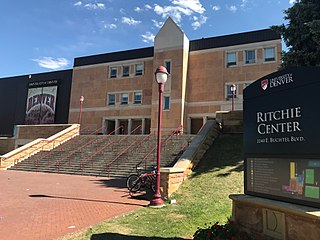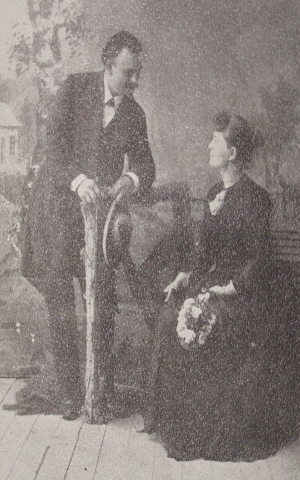
The Racquet and Tennis Club, familiarly known as the R&T, is a private social and athletic club at 370 Park Avenue, between East 52nd and 53rd Streets in Midtown Manhattan, New York City.

The Racquet Club of Philadelphia (RCOP) is a private social club and athletic club in Philadelphia, Pennsylvania. It has facilities for squash, real tennis, and racquets. The club is ranked in the Top 20 Athletic Clubs on the Platinum Club of America list.

Elitch Gardens was a family-owned seasonal amusement park, theater, and botanic garden in the West Highland neighborhood in northwest Denver, Colorado, United States, at 38th and Tennyson streets. For more than a century Elitch's was one of the most popular entertainment destinations in Colorado. It was nationally known for its luscious gardens, the Elitch Theatre, the Trocadero Ballroom, and the premier wooden roller coaster, Mister Twister. The park moved to downtown Denver in 1994 and later in November 1998 became Six Flags Elitch Gardens. The former location has been redeveloped.

Highland is a distinct city-center neighborhood in Denver, Colorado, United States, bounded by West 38th Avenue to the north, a Union Pacific Railroad line on the east, the South Platte River to the southeast, Speer Boulevard on the south, and Federal Boulevard on the west. The Highlands is sometimes used to refer to two separate city-center neighborhoods in Denver; Highland and West Highland, although the two neighborhoods are distinct. Highland and West Highland are both in the area that is referred to as the Northside. Highland is located immediately northwest of downtown. Note that the Highland neighborhood association has a slightly different definition with the easternmost boundary stopping at I-25. And the West Highland neighborhood to the immediate west of Highland, with the borders of 38th and 29th Avenues on the north and south and Federal and Sheridan Boulevards on the east and west. To distinguish between its immediately adjacent neighbor, West Highland, Highland is sometimes referred to as East Highland, Lower Highland or LoHi. The two together are casually called "the Highlands," a term which often falsely encompasses other Northwest Denver neighborhoods such as Jefferson Park, Sunnyside and Berkeley. Realtors have particularly pushed the inclusion of the recently gentrified Berkeley, located directly north of West Highland, as part of the Highlands, sometimes going so far as to refer to Berkeley and parts of Sunnyside as the "Upper Highlands". To add further confusion, within the Highlands neighborhoods there are several historic designations of various degrees, including Potter Highlands, Scottish Highlands and Highlands Park.

The Historic Elitch Theatre is located at the original Elitch Gardens site in northwest Denver, Colorado. Opened in 1890, it was centerpiece of the park that was the first zoo west of Chicago. The theatre was Denver's first professional theatre, serving as home to America's first and oldest summer-stock theatre company from 1893 until the 1960s. The first films in the western US were shown there in 1896. Cecil B. DeMille sent yearly telegrams wishing the theatre another successful season, calling it "one of the cradles of American drama."

The Multnomah Athletic Club is a private social and athletic club in Portland, Oregon, United States.

The Baldwin School is a private school for girls in Bryn Mawr, Pennsylvania, United States. It was founded in 1888 by Florence Baldwin.

The Beach Club Residences is an apartment community, health club, and commercial center in Minneapolis, Minnesota, United States, just across Lake Street from its namesake Lake Calhoun. Its founders intended the club to meet their residential, recreational, and entertainment needs in one building. The original building was listed on the National Register of Historic Places on December 23, 2003. It is considered significant as a rare local example of an apartment hotel, a distinctive urban housing option of American cities in the 1920s.

The David Whitney House is a historic mansion located at 4421 Woodward Avenue in Midtown Detroit, Michigan. The building was constructed during the 1890s as a private residence. It was restored in 1986 and is now a restaurant. The building was listed on the National Register of Historic Places in 1972.

1600 Glenarm Place is a 384 ft (117m) tall skyscraper in Denver, Colorado. Originally constructed in 1967 as the Security Life Building - it has since been converted into a multi-tenant luxury apartment complex. On the top floor of this building many years ago; there was a restaurant called Top Of The Rockies. The exterior of the building used to hold a separate elevator shaft for a glass elevator which served the restaurant. The restaurant has been gone for many years. After operating for many years as an office building, in 2006, the Security Life Building underwent a major conversion to residential use. 1600 Glenarm Place is in the heart of Downtown Denver. The high-rise sits on the corner of 16th Street Mall and Glenarm Place, next to the Denver Pavilions.

Fairmount Cemetery in Denver, Colorado, was founded in 1890 and is Denver's second oldest operating cemetery after Riverside Cemetery. It is located in land south-east of the intersection of the major Denver roadways Alameda Ave. and Quebec St.. The cemetery was designed by German landscape architect Reinhard Schuetze. The cemetery was patterned after Mount Auburn Cemetery in Cambridge and Watertown, Massachusetts. The cemetery occupies 280 acres (110 ha). The first year the cemetery opened over 4500 trees and shrubs were planted by Schuetze. The cemetery is the largest arboretum in the state.

The Daniel L. Ritchie Center is the home of athletics for the University of Denver in Denver, Colorado, United States. There are 17 athletic programs for the Denver Pioneers which run out of the Ritchie Center. The 440,000 square feet (41,000 m2) building cost $84 million to construct. Each of the 17 athletic programs have offices located on the fourth floor, along with the Gottesfeld room, which hosts a great deal of dinners and meetings. In addition, the third floor has offices for athletic advisors and other faculty members.

The University of Colorado Denver is a public research university located in downtown Denver, Colorado. It is part of the University of Colorado system. Established in 1912 as an extension of the University of Colorado Boulder, CU Denver attained university status and became an independent institution in 1973. CU Denver is the largest research university in Colorado, and is classified among R1: Doctoral Universities - Very High Research Activity. The university's graduate programs award more master's degrees than any other institution in the state, serving roughly 5,000 students annually.

Mary Elitch Long was one of the original owners of Elitch Gardens in Denver, Colorado. She was the first woman to own and manage a zoo—the first zoo between Chicago and the west coast—and one of the first women to own and manage a theater She was an author of two children's books and was inducted into the Colorado Women's Hall of Fame in 1996.

John Elitch Jr. was a restaurateur, businessman, actor, zookeeper, and original owner and namesake of Elitch Gardens and the Elitch Theatre in Denver, Colorado.
The following is a timeline of the history of the city of Denver, Colorado, United States, from its founding in 1858 to the present.

The Denver Press Club, located at 1330 Glenarm Place, Denver, Colorado, is the oldest press club in the United States. Journalists first met in 1867, and the club was incorporated in 1877.
Merrill H. Hoyt was a prominent American architect, business man and leader in the building design community of Denver, Colorado from 1910 to 1933.

The Owen E. LeFevre House is a historic home in Denver, Colorado. It was built prior to 1896, when it became the home of Owen E. Levre. At that time it had a carriage entrance gate from 13th Street to the southwest of the house. It was listed on the National Register of Historic Places on August 13, 1976.




















